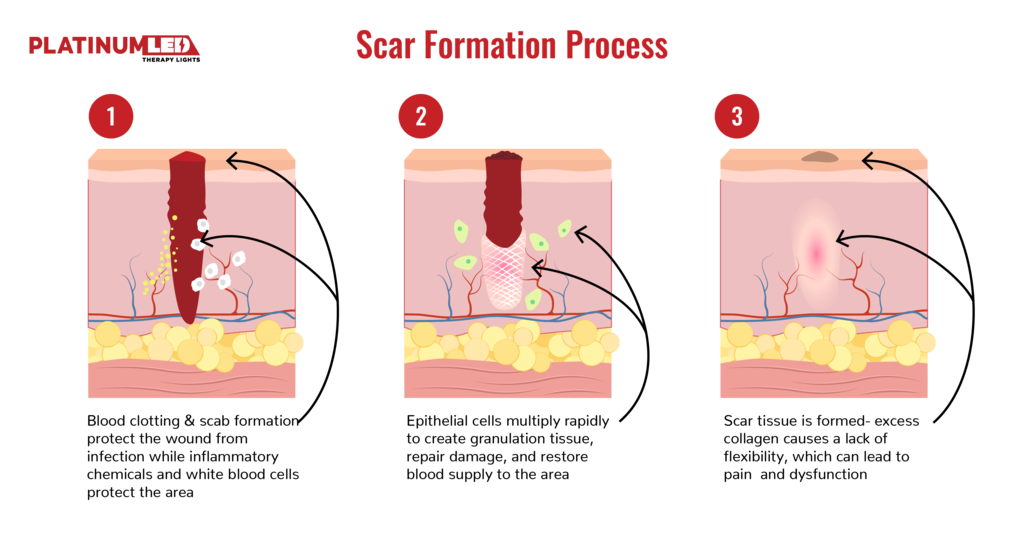Scar Prevention and Treatment
Wound healing depends on the type of cut, method of closure, and individual immune response.
© By Thomas Newman, TeachMeSurgery [CC-BY-NC-ND 4.0]
The inflexibility in scar tissue is due to rigid collagen deposits at the site of newly repaired tissue. Breaking up these tough fibers will soften the skin.
© PlatinumLED Therapy Lights
In the right hands, even the toughest scars can see dramatic improvement.
© Photo by OptiSkin.
What Causes a Scar
After an injury from a burn, a cut, or an inflammatory condition like cystic acne, the skin will heal itself by producing collagen to seal any wounds and regenerating new cells. The new cells that close the gap of the scar are called granulation tissue. These new cells behave differently than regular skin and are highly sensitive to even minor changes.
Good Scars vs. Bad Scars
In ideal healing circumstances, the granulation tissue remodels the empty gap between two edges of skin with minimal scarring. If the granulation tissue regenerates too quickly or produces disorganized collagen, it will create a raised bump or ridge. In rarer cases, the cells may produce too little collagen, creating a depressed (or pitted) scar. Additionally, the new cells may have slightly different pigment from the surrounding skin, leaving a visible mark. Although scars are theoretically a good thing because they indicate the skin has healed, most of us would rather not have a visible reminder of an injury, surgery, or acne. So, at OptiSkin, we’ve developed effective non-invasive strategies to diminish most types of unwanted scarring.
Primary vs. Secondary Wound Healing
Primary intention wound healing refers to a surgical incision made with an ultra-sharp scalpel. The wound edges are typically closed with sutures (stitches) and covered with a bandage. These wounds tend to heal with a linear scar.
Secondary closure occurs in a damaged area that is wide, irregular, or infected; all these would prevent a dermatologist from completely closing the skin. These wounds have disorganized remodeling leaving paths of zig-zagged collagen, which causes an irregular bumpy surface.
Scar Gels for After Surgery?
In short, yes. The ideal conditions for wound healing are to mimic the environment of your own epidermis. Silicone-based scar-gels trap moisture between the surface of the skin and optimizes wound healing. However, every wound is different, and patients should refer to their physician for specific guidance for post-operative care.
How a Scar is Treated at OptiSkin
In typical scar removal, our goal is to reduce disorganized collagen, promote healthy organized collagen formation, and optimize skin pigmentation. At OptiSkin Medical, we can take a deeper dive using non-invasive imaging to fully understand the depth and architecture of the individual scar. To treat the scar, we take a layered approach using radiofrequency micro-needling, platelet-rich plasma, non-ablative lasers combinations, laser-resurfacing, nano-penetration techniques, or topical/intralesional steroid applications. While each treatment program is customized to meet an individual’s needs, most patients report minimal to no downtime. They can return to their regularly scheduled lives right after a treatment.
Scar Prevention
Preventing scars from forming in the first place is a big part of our mission at OptiSkin, where our motto is Cutting Edge Without the Cutting™. Thanks to non-invasive imaging devices like optical coherence tomography (OCT) and reflectance confocal microscopy (RCM), we can detect, diagnose, and marginate skin cancer lesions without ever picking up a scalpel.
For melanoma tumors, we work closely with our Mohs surgeons and plastic surgeon colleagues to create the smallest possible scar while ensuring safety. Our unique ability to use non-invasive imaging allows us to catch lesions in their earlier stages, decreasing the size of surgeries.
Are You a Good Candidate?
While the appearance of almost any type of scar can be improved, scheduling a consultation with Dr. Markowitz is the best way to set expectations and determine the appropriate course of action for your skin.
Current as of: June 28, 2021
Author: OptiSkin Staff
Medical Review: Orit Markowitz, MD

![Wound healing depends on the type of cut, method of closure, and individual immune response. © By Thomas Newman, TeachMeSurgery [CC-BY-NC-ND 4.0]](https://images.squarespace-cdn.com/content/v1/5ffe0e466bc2b46dd696bcd9/1612838621881-T1DVS9L3QH8QGID7KOH3/PrimaryVsSecondaryLabelled-copy-scaled.jpg)

